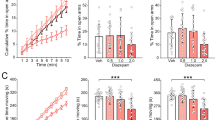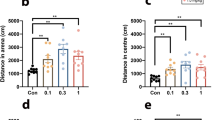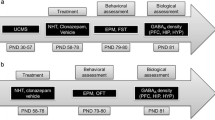Abstract
Rationale. CRF1 antagonists may be effective in the treatment of anxiety disorders while having fewer side effects compared with classical benzodiazepines.
Objectives. The effects of a small molecule selective CRF1 antagonist DMP696 on anxiety-like behaviors and stress-induced increases in corticosterone in rats exposed to a novel environment and on locomotor activity and motor coordination were determined in rats. These effects of DMP696 were compared with those produced by the classical benzodiazepine chlordiazepoxide (CDP).
Methods. DMP696 or CDP were administered PO, 60 minutes before behavioral testing in rats. Their effects on latency to exit a dark chamber and stress-induced increase in corticosterone in the Defensive Withdrawal test (an animal model of anxiety), locomotor activity, and rotorod performance (measure of ataxia) were determined.
Results. DMP696 significantly reduced exit latency and reversed the stress-induced increase in corticosterone in the Defensive Withdrawal test at doses of 3.0–10 mg/kg and higher. In contrast, CDP significantly decreased exit latency at 10 and 30 mg/kg, but not at 100 mg/kg, due to concurrent non-specific side effects. Unlike DMP696, CDP had no effect on the stress-induced increase in corticosterone at lower doses, but resulted in a significant increase at higher doses. DMP696 did not reduce locomotor activity or impair motor coordination at doses up to 30-fold higher than doses effective in the Defensive Withdrawal model. In contrast, CDP produced significant sedation and ataxia at the same doses that were effective in reducing exit latency.
Conclusions. These data suggest that the CRF1 antagonist DMP696 might retain the therapeutic benefits of classical benzodiazepines but have fewer motoric side effects.
Similar content being viewed by others
Author information
Authors and Affiliations
Additional information
Electronic Publication
Rights and permissions
About this article
Cite this article
McElroy, J.F., Ward, K.A., Zeller, K.L. et al. The CRF1 receptor antagonist DMP696 produces anxiolytic effects and inhibits the stress-induced hypothalamic-pituitary-adrenal axis activation without sedation or ataxia in rats. Psychopharmacology 165, 86–92 (2002). https://doi.org/10.1007/s00213-002-1239-3
Received:
Accepted:
Issue Date:
DOI: https://doi.org/10.1007/s00213-002-1239-3




